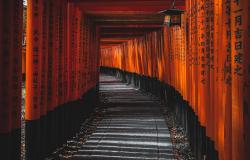To engage or not to engage? Japan’s relationship with civil society at the G7

International Media Centre, Hiroshima Summit - Gregory Stiles and Hugo Dobson report on the summit's evolving relationship with civil society.
Kanson minpi, which literally translates as ‘respect officials and despise the people’, is the pre-war term that has traditionally captured the relationship between the Japanese state and its people. The associated stereotype is one of docility and a shō ga nai (it can’t be helped) attitude on the part of the Japanese. Yet this is, clearly, reductive in that it ignores a long history of popular protest, as well as being blindly essentialist in that similar attitudes can be seen in other countries (take for example, the rise of what Adam Curtis has termed ‘Oh Dearism’ in post-Cold War Western news reporting). In fact, over the last quarter of a century, Japan has witnessed a substantial growth in its civil society triggered by the 1998 NPO Law, which enabled civil society organizations (CSOs) to acquire nonprofit corporation status.
At the same time, the relationship between the G7 and civil society has steadily evolved. Writing in 2000, Peter Hajnal catergorized this evolution into three stages starting with mutual ignorance and non-recognition in the 1970s and 1980s. Thereafter, this morphed into mutual recognition and finally resulted in a two-way approach that targeted specific issues.
Kamila Szczepanska of the University of Turku has traced this history across three G7/8 summits: Kyūshū-Okinawa in 2000, Hokkaidō-Toyakō in 2008 and Ise Shima in 2016. Within this history, the Japanese government has played an important, although inconsistent, role in shaping this relationship.
For example, at the 2000 Kyūshū-Okinawa summit, the Japanese government was a pioneer by constructing the first-ever NGO centre in order to provide a venue for advocacy groups to engage with the G8. As was noted at the time, the building of this centre had important symbolic value regarding the need for NGO inclusion. However, reality failed to meet this ideal. The centre was significantly under-used because it was located a considerable distance away from the International Media Centre (IMC), while the NGOs had to pay to use the centre and undergo security procedures that many deemed overly invasive and a form of surveillance. In essence, this was a failure to understand the nature and the role of civil society engagement with the G7.
At the 2008 Hokkaidō-Toyakō summit, Japanese civil society representatives mobilized on a grand scale and were organized through the 2008 Japan G8 Summit NGO Forum ahead of the summit around specific agenda items. Their interactions with the Japanese government were open and cooperative in nature with Prime Minister Fukuda Yasuo meeting with a number of NGO representatives. Dedicated space was provided for Japanese and international CSOs but they were also accredited alongside the world’s media and able to engage with them within the IMC, communicate their agendas directly and attend leaders’ press conferences.
Seven years ago, we were based in the IMC at the 2016 Ise Shima summit and able to observe engagement with civil society. This time NGOs found themselves separated from the IMC by a security checkpoint, unable to gain easy access, and were instructed that they could not display posters, signs or any promotional material outside the NGO centre. This played itself out most tellingly in the case of the Save the Children Universal Health Coverage (UHC) G7 Superheroes.These cardboard cutouts presented each G7 leader as a Manga superhero championing the UHC. They were meant to appeal to both the G7 leaders and the world’s media. However, restrictions meant that these cutouts were only displayed in the NGO centre, which was off the beaten track of the average journalist. As was the case in Okinawa, the treatment of civil society appeared to be more about the symbolic value than meaningful engagement.
Ultimately, as Szczepanska concludes, ‘the norm of civil society inclusion in global governance processes has not yet taken sufficient hold among Japanese ruling elites’, and the openness of the relationship with civil society differs summit by summit.
This year’s Hiroshima summit appears to represent a return to the Ise Shima model. Representatives from several of the large and small, well-known and less well-known, domestic and international NGOs have been provided with a centre in which they are holding press conferences, but this centre is in a separate building to the main IMC, again, out of sight of the majority of international journalists. Some Japanese and international NGOs do have access to the main IMC and are able to rub shoulders with the world’s media and disseminate their appeals to both the G7 leaders and the world to engage with their issues. However, the number of passes is limited.
In any case, probably the most significant development since the last G7 summit hosted
by Japan in Ise Shima is the formalisation of G7 engagement with civil society through the
emergence of the Civil 7 (C7). Following the template for engagement created by the G20, the C7 is one of the suite of official engagement G7 groups that sits alongside the Business 7, Labour 7, Think 7, Women 7, Youth 7, and joined this year for the first time by the Pride 7 (7). The P7 is an innovation in G7 summitry that brings together international and Japanese activists and allies in order to place LGBT issues on the agenda of the Hiroshima summit. However, the flipside of this initiative is that Japan remains the only G7 country not to recognise same sex marriages or civil unions and Kishida is currently struggling to steer meaningful LGBT legislation through the Japanese Diet. Once again, the Japanese government’s engagement with civil society presents us with something of a curate’s egg.
Please check here for other live posts from the event.
Photo by D J


